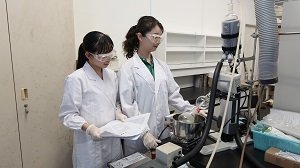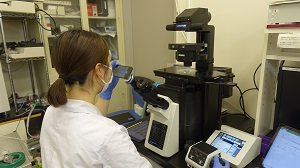Cultivate advanced academic knowledge and research skills through the exploration of the functions of materials and living organisms
The Division of Material and Biological Sciences conducts research and education on the materials and diverse functions of living organisms as one of the forms of materials, at each level of the hierarchy, such as molecules, molecular complexes, cells, and individual organisms. For this purpose, laboratories of different specialties in chemistry and biology are located at each level of the hierarchy so that organic cooperation between them is made possible. The Division consists of the following three subdivisions, each of which conducts research and education in organic cooperation with the other while making the most of their respective characteristics.
Material Function:
The subdivision offers comprehensive research and education from a microscopic viewpoint on the mechanisms of functional manifestations of materials based on the fundamental elements that constitute materials. Major research themes of the faculty members include: reaction kinetics of organic and inorganic molecules; photochemical processes by laser spectroscopy; development of X-ray spectroscopic methods; environmentally-friendly catalytic molecular transformations; development of synthetic methods for biologically active natural organic compounds and creation of functional molecules; bioanalysis; and elucidation of solid-liquid interface reactions and their application to environmental science.
Cellular and Molecular Function:
The subdivision focuses on cells, which are the basis of all living organisms, and provides research and education on their diverse structures and functions, as well as the mechanisms of their differentiation and expression, using organic chemistry, physical chemistry, and cell biology techniques. Major research themes of the faculty members include: NMR analysis of biomolecules; ultrastructure and functional expression of function of cells; control mechanisms of DNA replication; brain cells and behavior in vertebrates; and genetic manipulation of higher animals.
Physiological and Molecular Function:
This subdivision explores how genetic material, the basis of living organisms, is controlled by bioactive substances to cause biological responses such as proliferation, development, differentiation, and behavior, at the individual, cellular, and molecular levels. Major research themes of the faculty members include: reproductive physiology in plants; analysis of the structure and function of proteins produced by microorganisms; biogeochemical cycles in forest ecosystems; and molecular mechanisms of animal development and behavior.
Human Resource Development and Educational and Research Purposes
The objective of the Division is to nurture human resources who are able to explore the functions of inorganic materials, organic materials, cells, and individuals in a wide range of educational and research fields covered by materials science and biological science from a functional point of view.
List of subject names
Faculty member introduction
Faculty members with a wide range of specialties provide education.




